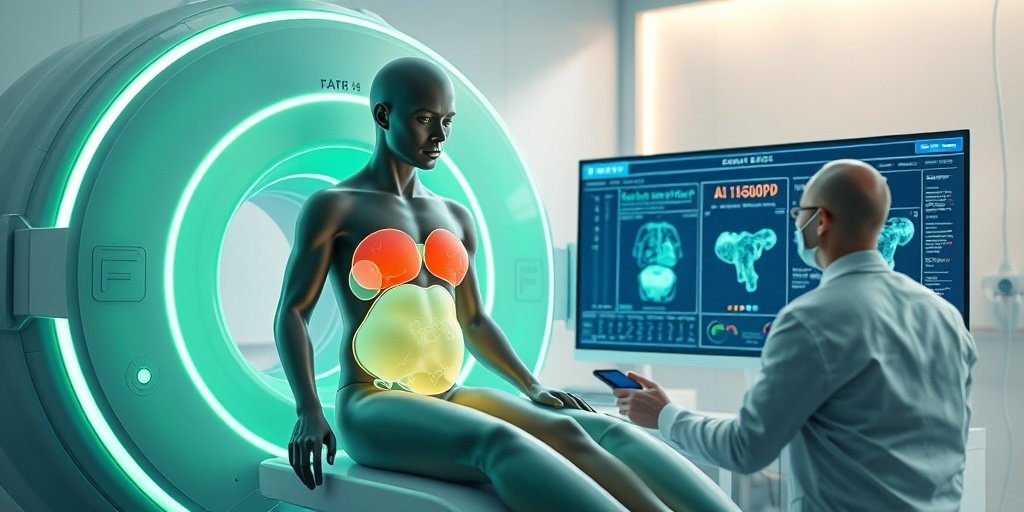⚡ Quick Summary
This review highlights the transformative role of artificial intelligence (AI) in the imaging of visceral adipose tissue (VAT) and ectopic fat, significantly enhancing the accuracy and efficiency of cardiovascular disease (CVD) risk assessments. By integrating AI with clinical data, we can achieve a more personalized approach to managing obesity and cardiovascular risks. 🌟
🔍 Key Details
- 📊 Focus: AI in VAT and ectopic fat imaging
- 🧩 Key Technologies: Deep learning models
- ⚙️ Applications: Early detection of cardiometabolic risks, telehealth, and wearable technologies
- 🏆 Outcomes: Improved segmentation and risk prediction capabilities
🔑 Key Takeaways
- 🤖 AI enhances imaging of visceral and ectopic fat, crucial for assessing cardiovascular risk.
- 📈 Deep learning models significantly improve segmentation accuracy.
- 💡 Early detection of cardiometabolic risks is facilitated through AI integration.
- 🌐 Telehealth applications are emerging, allowing continuous monitoring of patients.
- 🔍 Personalized medicine is becoming more achievable through AI’s integration with clinical data.
- ⚠️ Challenges remain, particularly in model interpretability and clinical application.
- 🔮 Future research will focus on refining algorithms and expanding AI’s role in clinical settings.

📚 Background
The assessment of visceral adipose tissue (VAT) and ectopic fat is critical in understanding cardiovascular disease (CVD) risks. Traditional imaging techniques often lack the precision needed for effective risk stratification. With the advent of artificial intelligence, there is a promising opportunity to enhance the accuracy and efficiency of these assessments, paving the way for more effective management of obesity and related health risks.
🗒️ Study
This review synthesizes recent findings on the application of AI in adipose imaging, particularly focusing on how deep learning models can improve the segmentation of VAT and ectopic fat. The authors explore the integration of imaging data with clinical information, which is essential for personalized risk assessment and management strategies.
📈 Results
Recent studies indicate that AI-driven approaches have led to significant improvements in the segmentation of VAT and ectopic fat. These advancements enable earlier detection of cardiometabolic risks and facilitate a more personalized approach to patient care. The integration of AI with large datasets enhances the predictive capabilities for cardiovascular risk assessment, making it a vital tool in modern medicine.
🌍 Impact and Implications
The implications of AI in adipose imaging are profound. By enabling more precise and scalable assessments of fat distribution, AI is set to revolutionize how we approach obesity and cardiovascular risk management. The potential for AI-enabled telehealth and continuous monitoring through wearables could significantly enhance patient outcomes and healthcare delivery.
🔮 Conclusion
This review underscores the transformative potential of AI in the field of adipose imaging and cardiovascular risk assessment. As we refine these technologies and address existing challenges, the future of personalized medicine looks promising. Continued research and development in this area will likely redefine how we manage obesity and cardiovascular health, leading to better patient outcomes and more effective healthcare strategies.
💬 Your comments
What are your thoughts on the integration of AI in adipose imaging and cardiovascular risk assessment? We would love to hear your insights! 💬 Leave your comments below or connect with us on social media:
AI in Adipose Imaging: Revolutionizing Visceral Adipose Tissue, Ectopic Fat, and Cardiovascular Risk Assessment.
Abstract
PURPOSE OF REVIEW: This review explores the role of artificial intelligence (AI) in visceral adipose tissue (VAT) and ectopic fat imaging. It aims to evaluate how AI may be used to enhance the efficiency and accuracy of cardiovascular disease (CVD) risk assessment. It addresses key questions regarding AI’s capabilities in risk prediction, segmentation, and integration with large volume data for CVD risk assessment.
RECENT FINDINGS: Recent studies demonstrate that AI, powered by deep learning models, significantly improve VAT and ectopic fat segmentation. AI can also be used to facilitate early detection of cardiometabolic risks and allows integration of imaging with clinical data for a more personalized approach to medicine. Emerging applications include AI-enabled telehealth and continuous monitoring through wearable technologies. AI is transforming VAT and ectopic fat imaging by enabling more precise, personalized, and scalable assessments of fat distribution and cardiovascular risk. While challenges remain, such as model interpretability, future research will likely focus on refining algorithms and expanding AI’s clinical applications, potentially redefining obesity and CVD risk management.
Author: [‘Kandi SR’, ‘Khera R’, ‘Rajagopalan S’, ‘Neeland IJ’]
Journal: Curr Atheroscler Rep
Citation: Kandi SR, et al. AI in Adipose Imaging: Revolutionizing Visceral Adipose Tissue, Ectopic Fat, and Cardiovascular Risk Assessment. AI in Adipose Imaging: Revolutionizing Visceral Adipose Tissue, Ectopic Fat, and Cardiovascular Risk Assessment. 2025; 27:101. doi: 10.1007/s11883-025-01356-1